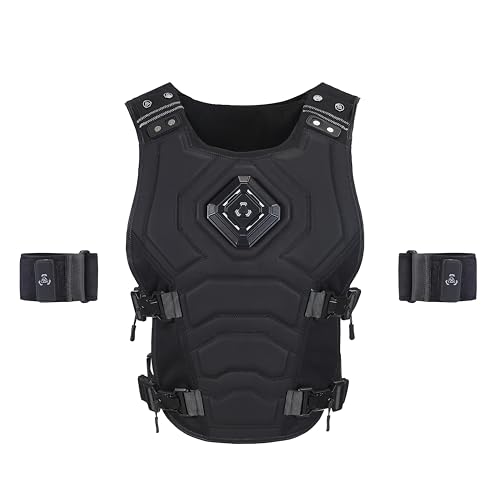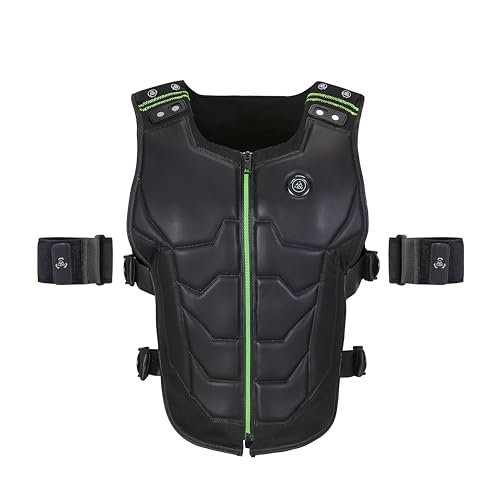As VR technology evolves, choosing the right haptic suit can greatly enhance your gaming experience. In 2025, several options stand out, each with unique features that cater to different preferences and setups. From suits with advanced vibration units to those that include electrical stimulation, the choices can be overwhelming. Let’s explore the top four VR haptic suits that promise to elevate your immersion to new heights. You might be surprised by what you find.
Skywin Vive Tracker Straps for HTC Vive
If you’re looking to elevate your VR experience, the Skywin Vive Tracker Straps for HTC Vive are a game changer for any serious VR enthusiast. These straps offer full-body tracking compatibility with HTC Vive trackers, enhancing your immersion in VRChat, fitness apps, and motion-based games. Featuring two waist belts and four hand straps, they guarantee a secure and comfortable fit, allowing you to move freely without slipping. Made from durable, high-quality materials, these lightweight straps provide stability for intense sessions. Plus, their adjustable design accommodates all body types, making them a must-have for anyone wanting precise movement tracking.
Best For: Serious VR enthusiasts looking to enhance their immersive experience in applications like VRChat and fitness games.
Pros:
- Enhanced Tracking: Provides full-body tracking with waist and hand straps for seamless movement in VR.
- Comfortable Fit: Features breathable, padded straps that ensure a snug, adjustable fit for all body types.
- Durable Construction: Made from high-quality materials, designed for long sessions and heavy usage without compromising performance.
Cons:
- Trackers Not Included: Requires separate purchase of HTC Vive trackers for full functionality.
- Initial Adjustment Period: Users may need time to adjust to the straps for optimal comfort and performance.
- Limited Compatibility: Specifically designed for HTC Vive trackers, not suitable for other VR systems.
TrueGear Haptic suit ME (TrueGear Haptic Suit ME02)
The TrueGear Haptic Suit ME (TrueGear Haptic Suit ME02) stands out with its impressive 40 vibration feedback units, making it a top choice for gamers who crave an immersive virtual reality experience. Weighing just 3.3 pounds, it features Bluetooth connectivity for easy game connection. With a robust 10,000mAh battery, you can even reverse charge your headset. While it supports 50 mainstream VR games and offers customizable haptic effects, some users report compatibility issues with Meta Quest 3. Weekly updates guarantee you stay current, but the 3.3-star rating suggests room for improvement. Still, the immersive feedback can enhance your gaming sessions considerably.
Best For: Gamers seeking an immersive virtual reality experience with customizable haptic feedback.
Pros:
- 40 vibration feedback units for an enhanced immersive experience.
- Bluetooth connectivity allows for easy one-click game connection.
- 10,000mAh battery supports reverse charging of headsets.
Cons:
- Reports of compatibility issues with Meta Quest 3.
- Mixed customer ratings with an average of 3.3 out of 5 stars.
- Limited support with only 50 mainstream VR games available.
Meta Quest 3/3S Adjustable Elite Head Strap with Face Pad Cover
Designed specifically for the Meta Quest 3 and 3S, the Adjustable Elite Head Strap with Face Pad Cover offers exceptional comfort for avid gamers. Weighing just 8 ounces, its lightweight, polymeric design enhances breathability for those long gaming sessions. Adjustable knobs guarantee a snug fit, accommodating various head sizes while relieving facial pressure. Many users rave about the significant comfort improvement over the stock strap, allowing for extended play without discomfort. While some have faced quality control issues, the strap’s overall performance and value make it a solid choice for enhancing your VR experience.
Best For: Avid gamers seeking enhanced comfort and support during long VR sessions with their Meta Quest 3 or 3S.
Pros:
- Adjustable design accommodates various head sizes for a secure fit.
- Lightweight and breathable material enhances comfort for extended wear.
- Significant improvement in comfort over stock strap, allowing for longer gaming sessions.
Cons:
- Some users report quality control issues, such as missing parts or discrepancies in material quality.
- Larger size may lead to compatibility issues with existing VR headset cases.
- Concerns about the durability of materials and stability of connection points.
TrueGear Haptic suit ME (TrueGear Haptic Suit ME01)
For gamers seeking an immersive experience, the TrueGear Haptic Suit ME (TrueGear Haptic Suit ME01) stands out with its impressive 40 vibration feedback units and customizable haptic effects. Weighing just 3.3 pounds, it features adjustable wear and a Bluetooth connection for easy setup. You’ll enjoy seamless integration with 50 mainstream VR games, thanks to weekly updates and one-click game connection. The suit also includes two sets of electrical stimulation arm rings to enhance your gameplay. Plus, with a robust 10,000mAh battery that can reverse charge your headset, you won’t have to worry about running out of power mid-session.
Best For: Gamers looking for an immersive VR experience with advanced haptic feedback and customizable features.
Pros:
- Offers 40 vibration feedback units for enhanced immersion.
- Seamless integration with 50 mainstream VR games and continuous updates.
- Adjustable wear and Bluetooth connectivity for user convenience.
Cons:
- May require a learning curve for setup and customization.
- Limited to compatibility with specific VR games.
- Relatively heavy weight compared to other gaming accessories.
Factors to Consider When Choosing Vr Haptic Suits
When choosing a VR haptic suit, you need to take into account several key factors to guarantee the best experience. Look at compatibility with your VR system, comfort and fit, and the haptic technology features. Don’t forget to evaluate battery life and the range of games that are compatible with the suit.
Compatibility With VR Systems
Choosing a VR haptic suit that works seamlessly with your VR system is essential to fully enjoy the immersive experience. Verify the suit is compatible with your specific platform, as some are limited to certain devices. Check the number of supported mainstream VR games; a broader selection indicates better versatility. Look for suits with easy connectivity options like Bluetooth, which streamlines integration with your headset and gaming platforms. Compatibility with accessories such as VR trackers can greatly enhance tracking accuracy and motion feedback, elevating your gameplay. Finally, consider manufacturers that provide regular software updates, as these can improve compatibility and expand support for new games, guaranteeing your haptic suit remains relevant and functional for years to come.
Comfort and Fit
A comfortable and well-fitting VR haptic suit is essential to your immersive experience, as it helps you stay focused without distractions. Look for adjustable features that accommodate various body types, ensuring a snug fit without limiting your movement. Breathable materials are vital too; they reduce heat buildup and keep you comfortable during long gameplay sessions. Consider the weight of the suit; lighter options can help minimize fatigue and improve wearability over time. Additionally, pay attention to ergonomic design elements that distribute pressure evenly across your body. This thoughtful design not only enhances comfort but also allows you to fully engage in your virtual adventures. Prioritize comfort and fit to elevate your VR experience to new heights.
Haptic Technology Features
Selecting the right haptic technology features can considerably enhance your VR experience. Look for suits with multiple vibration feedback units—around 40 is ideal—to simulate sensations that correspond to in-game actions. Electrical stimulation elements, like arm rings, further boost tactile feedback, making interactions feel more realistic. Bluetooth connectivity is essential, too; it guarantees seamless integration with your VR system, allowing for quick game connections without complicated setups. Also, consider suits with powerful batteries, like a 10,000mAh option, which support extended play and even reverse charge your VR headset. Finally, prioritize suits that receive continuous software updates, keeping them compatible with a broad range of VR games and enabling you to customize haptic effects for an evolving user experience.
Battery Life and Charging
Battery life is an essential factor when it comes to maximizing your VR haptic suit experience. When choosing a suit, pay attention to the battery capacity; a higher mAh rating usually means you can enjoy longer sessions without needing a recharge. Look for suits with reverse charging capabilities, so you can power other devices during lengthy gaming marathons. Also, consider the type of batteries; some suits use rechargeable lithium-ion batteries, while others rely on disposables, impacting long-term costs. Check the charging time, too—faster charging suits minimize downtime between sessions. Finally, features like battery life indicators are essential, helping you monitor remaining power and avoid unexpected interruptions while immersed in your virtual world.
Game Compatibility Range
When diving into the world of VR haptic suits, considering the game compatibility range is essential for maximizing your immersive experience. A wider compatibility range lets you enjoy haptic feedback across numerous popular VR titles, enhancing the thrill of gameplay. Many suits support around 50 mainstream VR games, so check what’s included before you buy. Customizable haptic effects can tailor the feedback to different games, making your experience more engaging based on in-game actions. Don’t overlook regular software updates; they can improve compatibility with new titles and enhance existing features. Finally, guarantee there’s no haptic delay—suits that eliminate this provide seamless integration with gameplay, boosting realism and immersion. Choose wisely to elevate your VR adventures!
Build Quality and Durability
A high-quality VR haptic suit not only enhances your gaming experience through compatibility but also needs to stand up to the rigors of intense gameplay. Build quality is essential; it determines how well the suit can withstand frequent use and the demands of action-packed sessions. Look for suits made from high-quality, rugged materials that resist wear and tear, ensuring longevity. Comfortable padding and adjustable components also help reduce stress on the materials during movement, enhancing durability. Additionally, consider weight; lighter suits might compromise on material strength, while heavier models often use more robust fabrics. Don’t forget that regular updates and maintenance from manufacturers can improve durability over time, addressing design flaws and enhancing overall performance.
Price and Value
While evaluating VR haptic suits, it’s crucial to contemplate both price and value to guarantee you’re making a smart investment. Start by reviewing the price in relation to features like vibration feedback units and battery capacity, as these greatly enhance your immersive experience. Consider the suit’s compatibility with mainstream VR games; those that support a wider range may offer better long-term value. Examine battery life and functionality—some suits can reverse charge other devices, saving you money on additional chargers. Look for suits that receive regular software updates, which can improve performance over time. Finally, review customer ratings to confirm the price reflects quality and comfort, especially for extended use. Your investment should enhance your VR experience for years to come.



